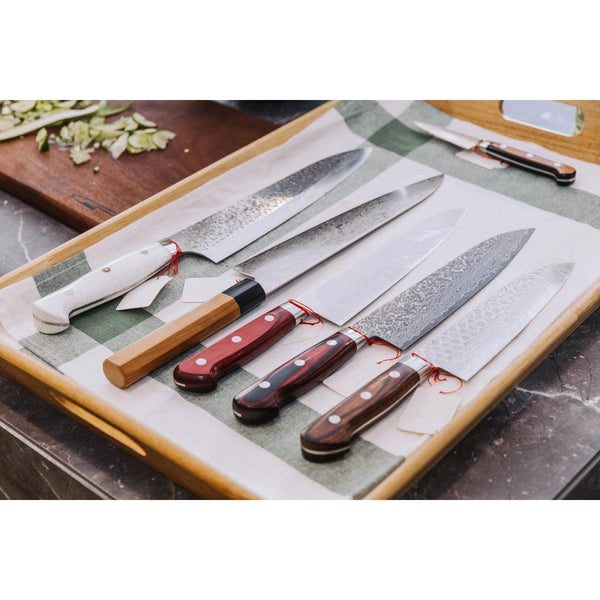
Jump to:
A good Japanese knife is an essential tool in any kitchen. From the small paring knife to the larger santoku, each style is designed with a specific purpose in mind. But with so many different types of Japanese knives to choose from, it can be difficult to know which one is best for your needs. In this article, we'll uncover the different types of Japanese knives and their uses so that you can make an informed decision when buying one.
How to Choose the Best Japanese Knife for Your Needs

Before purchasing a Japanese knife, here are a few points to consider:
Blade - when it comes to the blade of a Japanese knife, it’s worth considering the material it’s made from and what kind of blade it is as this will also affect things such as how easy it is to keep sharp and maintain.
For example, Japanese knives are usually made from carbon steel or stainless steel. Whilst carbon steel is easier to sharpen and stays sharp for longer, it’s more prone to rust and corrosion than stainless steel. Carbon steel knives also tend to be more expensive than their stainless-steel counterparts.
Another factor to consider when it comes to the blade is the size and type of blade. A longer, heavier blade of a gyuto may be more difficult for some people to use than a smaller petty knife. A double-bevel knife is a blade that is sharpened on both sides and can be used by left or right-handed people, whilst a single-bevel knife is only sharpened on one side and will only be suitable for left or right-handed users, depending on who the knife has been designed for.
Purpose – another important point to bear in mind is what kind of tasks will you mostly be using your knife for? If you plan to use it for multiple jobs such as cutting and chopping meat, vegetables, and herbs, then a general-purpose knife such as a gyuto or santoku is probably better than a sujihiki knife which is primarily designed for carving boneless meat and fish.
Handle/Grip – finally, the type of handle can also affect the feel and balance of the knife. Traditional Japanese knife handles are often made from wood and come in a D-shape, oval, or octagonal shape. The balance point tends to be further to the front on these handles, but on western-handle Japanese knives, the balance point is towards the back. A stainless-steel handle is also easier to clean and more hygienic than a wooden one.
Now that you know a little more about the kinds of features you can expect to find in Japanese knives, let’s explore some of the different types available.
Gyuto Chef’s Knife

This general-purpose Japanese knife is great for slicing, chopping, dicing, and cutting through boneless meat and other items such as vegetables and fruit. The knife is usually made from stainless steel to resist rusting and has a long blade with a slight curve that allows for efficient cutting.
The blade is normally thinner than a western chef’s knife making it more agile to use and its sharpness makes it perfect for precision work in the kitchen. With its versatility and durability, it has become an essential tool for professional (and home!) chefs all over the world. Check out our range of gyuto knives.
Santoku All-Purpose Knife

Another versatile knife that can be used for multiple purposes in the kitchen, the santoku is easy to use when chopping and slicing items like fish, meat, and vegetables. Although similar to the gyuto knife, there are small differences between the two. For example, the gyuto has a slighter different tip to the santoku and is a bit sharper, making it a little easier for cutting meat.
The tip of the santoku curves down slightly and has a less curved edge, making it slightly easier than the gyuto for chopping vegetables. Santoku also tend to have a slightly shorter blade than a gyuto so if you have smaller hands, you may find it more comfortable to use. There are many different santoku knives on the market, so to make it easier for you we've reviewed the ten best santoku knives on our blog.
Nakiri Vegetable Knife

A Japanese nakiri knife is primarily used for slicing and chopping vegetables. Its thin blade and sharp edge make it the perfect tool for making precise cuts with ease without removing the skin of the vegetable. With its unique shape, it is becoming increasingly popular in home kitchens around the world. It has quite a broad blade and blunt tip which makes it easy to chop vegetables and is the ideal knife for vegetarian chefs. Nakiri are also sharpened on both sides making them easy to use for left-handed and right-handed people.
Sujihiki Carving Knife

A sujihiki is used as a carving knife for boneless meat and fish and has a long slim blade that allows it to easily cut through pieces of meat without tearing. It can be used to trim fat and gristle, cut meat into thin slices, and is also ideal for filleting fish. The sujihiki’s design also makes it the perfect knife for preparing sashimi and other delicate ingredients.
Cleaver (chuka-bocho)

A cleaver knife, known as chuka-bocho in Japanese or a Chinese cleaver, is similar in appearance to a western cleaver but has a thinner and sharper blade and is more delicate than a Chinese-made cleaver. It is easily recognizable by its large rectangular-shaped blade and is ideal for tap-chopping and push-cutting techniques. This kind of knife is quite versatile and can be used for cutting a variety of ingredients including meat, fish, herbs, and vegetables.
Boning knife (honesuki)

Known as honesuki in Japanese, this kind of knife is ideal for deboning chicken and poultry and can be used for other tasks such as fileting fish too. It has a triangular-shaped blade which is relatively short and is highly efficient at breaking down a chicken into smaller pieces and for making precise cuts. For cutting through bones a honesuki is unsuitable – in this case, you’ll need a deba knife (see below).
Deba Knife

A deba knife is a traditional Japanese kitchen knife with a single-edged, heavy blade. It is primarily used to filet and cut through fish and seafood but can also be used to break down poultry and other meats. Its thick, strong blade makes it ideal for cutting through tougher items such as smaller bones and cartilage, making it a valuable tool for any chef or home cook. The knife’s unique design allows for the easy removal of fish heads and tails without damaging the knife and makes light work of fileting flesh from the bones and removing skin and scales.
Filet Knife

If you regularly perform tasks such as fileting fish and meat, then a Japanese filet knife is a perfect fit for your kitchen! There are a variety of different designs available, but filet knives generally are quite lightweight, and their blades typically curve upwards to allow for precise and quick cutting. You can also use this type of filet knife for slicing foods such as cheese and ham.
Sashimi Knife (Yanagiba)

The yanagiba is a traditional Japanese knife designed especially for slicing boneless filets of fish to prepare sashimi. It has a long narrow blade, is extremely sharp, and is ideal for cutting through raw fish in one single slicing motion. This design allows the fish to retain its flavor and texture without being damaged by the knife. As well as preparing sashimi and nigiri sushi, a yanagiba knife can also be used to filet small fish, and there are also sub-varieties of yanagiba too.
For example, a fuguhiki is used for preparing blowfish and has a thinner, narrower blade to handle the extremely thin and delicate slices of fish, whilst a takohiki is a version of yanagiba which comes from the Tokyo region and has a square tip which is useful for picking up slices of fish.
Petty Knife

A Japanese petty knife is a general-purpose kitchen knife ideally suited to slicing fruits and peeling vegetables. It can also be used to slice and dice poultry and fish, chop herbs, and make garnishes. It’s popular with professional chefs and home cooks because of its small size and multiple use options, making it ideal for users who find it easier to work with a smaller knife, have limited kitchen space, or have concerns about using a bigger knife like a gyuto. A Japanese petty knife is also ideal for making mukimono, the traditional Japanese art of decorative garnishing.
Japanese Steak Knife

A Japanese take on the western steak knife, a Japanese steak knife brings the best of Japanese knifemaking and high-quality materials into a familiar utensil with a high cutting performance. A good steak knife can easily cut through red meat without tearing and damaging it. You can also use a steak knife for cutting through items such as smaller fruits and vegetables and cheeses.
Japanese Butter Knife

Japanese butter knives make even the most solid butter easy to spread straight from the refrigerator without creating lumps or tearing the bread. Available in a variety of different designs, popular products include the Yoshikawa Nulu Butter Knife which has a unique angled handle that makes it easy to run the knife flat across the slab of butter. One side of the blade is perforated to effortlessly shred curls of butter, whilst the other side is serrated to spread butter or scrape off burnt toast.
Japanese Cheese Knife

Like the butter knife, cheese knives come in a wide range of designs, but generally, smaller paring-type knives are more efficient at cutting hard cheeses, whilst butter knives work better with soft cheeses. For a multi-purpose cheese knife that’s suitable for cutting both softer and harder cheeses, the Japanese Yoshikin Global Cheese Knife has a 14cm serrated blade designed specifically for cutting cheese.
Japanese Bread Knife

Japanese bread knives are usually made from stainless steel so that they are rust-resistant and easy to clean, and the handles are made from varying materials including stainless steel, plastic, and wood. Wooden handles are highly durable and easy to use, whilst steel handles prevent the growth of germs, making them more hygienic. Knives with a plastic handle tend to be more affordable. The blade on a bread knife is usually serrated to easily cut through bread without squashing or tearing it.
Where to buy Japanese knives online
You can find a wide selection of high-quality authentic Japanese knives from favorite brands such as Tojiro and Takamura Hamono as well as sharpening stones via the Japanese Taste store here.


0 comments